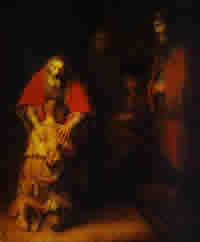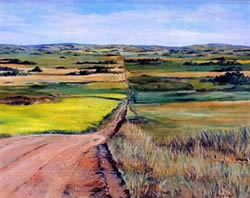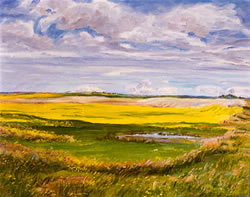Coming All the Way Home:
Affirming the “Incidental Face” of Creation
Guest essay by Daniel Deffenbaugh, Associate Professor of Philosophy and Religion at Hastings College in Hastings, Nebraska. His book, Learning the Language of the Fields: Tilling and Keeping as Christian Vocation (Cowley, 2006) was named one of the Best Spiritual Books of 2006 by Frederic and Mary Ann Brussat.
For Sunday March 18, 2007
Fourth Sunday in Lent
Lectionary Readings (Revised Common Lectionary, Year C)
Joshua 5:9–12
Psalm 32
Luke 15:1–3, 11b–32
2 Corinthians 5:16–21
 |
If there is anything that can be said for the winter landscape of Nebraska it’s that it knows how to cooperate in providing an appropriate setting for the observance of Lent. A season that begins with Jesus’ trial and temptation in the desert and moves gradually through the symbolic geography of reflection and repentance seems well suited for this part of the country. Here March rushes in like the King of Beasts and never gives the slightest thought to skipping out like a lamb. Winters are cold, and the wind is a constant adversary, tempting us to try to execute even the most basic of human tasks without bowing to its invisible power and dominion. The fields that were lush and green in the halcyon days of August are now just drifts of snow stretching out toward an endless horizon. I’ve always thought that there was an opportunity here that the state might do well to capitalize on. The ad campaign could target the spiritual seeker looking for a diversion from the customary forty days of abstinence: “Next Year, Do Lent Right! Come to Nebraska.”
There is a palpable loneliness on the open prairie for someone like me who was raised in the nurturing arms of the Appalachian Mountains, and I wonder if something akin to this emptiness is what finally drove the prodigal son—friendless and destitute, ashamed but still hopeful—back to the people who knew him best, back to his place. As Luke relates the parable (Luke 15:11–32), the younger of two brothers entreats his father for the inheritance that will eventually come to him in its proper time. Drawn to the excitement of a carefree existence in some “far country,” the young man indulges in a reckless lifestyle that too often accompanies the easy acquisition of wealth. It is not long, however, before he finds himself in the company of pigs—real pigs, not just the fair-weather-friend variety. In a short time he manages to turn his back on his family, forsake the familiarity of his homeland, and lose sight of his religious heritage (as suggested by his intimate knowledge of the swine pen). Devoid of these most basic relationships he becomes in effect a non-person. Those who lack the discipline for serious introspection will often be driven to it by circumstance, and this is what happens here. At this point the young man attains what Wallace Stevens called a “mind of winter,” an experience of emptiness in all things, an acute awareness of “the nothing that is not there and the nothing that is.” But it is not an experience utterly without hope, for he is still by grace able to utter the single word with which his entire misadventure began: “Father.”
 |
The events of the prodigal’s return are well known, but familiarity can breed a dullness of spirit that can often prevent us from hearing the story anew. Toward the end of his life the great Catholic theologian Henri Nouwen became particularly intrigued by Rembrandt’s rendering of this parable in his painting The Return of the Prodigal Son (c. 1662). Nouwen relates how over a period of several years he would return to this work simply to sit and contemplate its significance for his life. At first, he says, he was drawn to the image of the son kneeling at his father’s feet. His shaven head and tattered robe speak to the depths of the young man’s despair, but the gentle weight of his father’s hands assures the boy that there is still a place where he belongs. Nouwen perceived in this image a spiritual truth that he claimed as his own, that whatever he might lose in this life, he was still his father’s child. At another point in his journey Nouwen was taken by the image of the dutiful brother whose disdain for his sibling now made him the foreigner dwelling in the far country of contempt. How often, Nouwen asked, had his own vain sense of obligation and responsibility kept him from exercising his true humanity? Eventually Nouwen came to see in the father an aspect of his own spiritual life that needed constantly to be nurtured: the ability to show compassion and forgiveness, to welcome home each and every lost soul with the strong (left) hand of a father and the nurturing (right) hand of a mother.
When I ponder Rembrandt’s painting I have to admit that I am not first drawn to the prodigal, nor to the elder brother or even to the father. Perhaps it is a kind of artistic attention deficit disorder that afflicts me, but I find myself less concerned with the story as it unfolds among the prominent figures on the canvas and more intrigued by what is going on behind the scenes. The placement of the father and son on the left and the elder brother on the right reflects the distance and dysfunction that have been created by the affairs of the day, but I am fascinated by the way that Rembrandt chose to occupy the shadowy depths behind them all with a personal presence. Whose form is hovering there in the darkness? Is it simply a device for centering the vignette, encouraging the viewer to witness at once the full human drama of repentance, jealousy and compassion? What new insights into the story might we gain if we spend just a little time reflecting on this apparently incidental face?
 |
I believe Rembrandt’s Return of the Prodigal Son offers a kind of visual clue to the way that Christian theology has for centuries viewed the ordeal of human sin and redemption, as if it occurs solely on the plane of human history, with creation as little more than an “incidental face.” Over the last four decades many have criticized the Judeo-Christian tradition as having much to do with the current ecological embarrassments that we now face. The planet is heating up, fresh water is becoming scarcer, agricultural practices are contaminating the land, and our consumption is made all the more conspicuous by the garbage that strains the capacities of our landfills. Like the wayward son we have squandered our inheritance to the point that creation itself is adorned in tattered rags. But what should we expect, some would argue, from a tradition that has featured human dominion over a world that is not affirmed as our true home? Consider the commentary of Ephrem the Syrian (d. 373) on the real import of the prodigal’s return:
...A parable for those with perception
Is to be found in this homecoming:
Let us too return to our Father’s house,
My brothers, and do not become
captivated with desire
For this transient earth
– for your true city is in Eden (Hymns on Paradise 14:7).
Given our tradition and the gravity of our present ecological concerns, reconciliation and redemption must no longer be thought of as matters pertaining only to “fathers and sons.” We have come to a point in our history where the “incidental face” of creation needs to be brought out of the shadows and included as a full participant in the drama of redemption. As children of God, the confession of our sins “against heaven and before you” needs now to feature an additional clause: “we have sinned against creation by forsaking our home for some ‘far country’.”
The apostle Paul laid the foundation for a new way of understanding Christian repentance and redemption. In his Epistle to the Romans he makes a curious allusion: “[T]he creation waits with eager longing for the revealing of the children of God” (Romans 8:19). Paul’s logic in this is easy to comprehend: if we agree that the entire created order fell as a result of one man’s disobedience, then we must necessarily assume that the redemption effected in the work of Christ, the Second Adam, is not merely a human affair but extends also to the natural world. Consequently, the works of sanctification that are performed in gratitude by each and every Christian must reach into the very earth of which we are a part. Indeed, creation is waiting with “eager longing” for this. The Eden that Ephrem the Syrian believed to be our true home is not located in some “far country.” On the contrary, it is right here, right now, in the earth beneath our feet. So when Paul assures the Corinthians that in Christ they have become a “new creation” (2 Cor. 5:17), he chooses his words carefully. We are not merely renewed persons—as we are prone to think in our highly individualistic society—but a transformed people living in place. The “incidental face” that has lingered so long in the darkness, peering out with eager longing, must now be affirmed as a legitimate member of the Christian fold.
 |
Drifting snow and howling winds are not the last word on my Nebraska landscape, just as the season of Lent is only a temporary journey on the way toward the joy of Easter. Those who have endured the long prairie winters know that this land is a wonderful healer of itself, taking the harsh months and transforming them into a glorious profusion of flowers and indigenous grasses. The seeds and rhizomes of the plants remain dormant in the frozen soil awaiting the proper time for their own revelation as children of God. Yet not all is well here, as so many of our environmental problems attest, and I have to wonder where the voice of the church is in all of this. Are we content simply to see emptiness and otherness in our ecological community, thereby disavowing ourselves of any responsibility for its well being? For after all, God cares for the soul, not the soil. Or can we, like the prodigal son, find the slightest measure of hope that will encourage us to repent and come all the way home, to our family and to our place? To be a new creation, to be completely transformed by God’s grace, means that we will now need to be especially aware of the faces that have long lingered in the darkness awaiting our revelation as children of God. And the first step on our journey home begins with an earnest confession: “Father, we have sinned against heaven and before you... and we have sinned against creation.”
For further reflection:
* With which figure in Rembrandt’s Return of the Prodigal Son do you identify most?
*
Are there ways that you might acknowledge your Christian responsibility toward creation in your Lenten disciplines this year? What habits might you curtail, or what practices might you adopt?
*
If your church community could take three easy steps toward being a better steward of creation what would they be?
* See my book Learning the Language of the Fields: Tilling and Keeping as Christian Vocation (Cowley, 2006).





